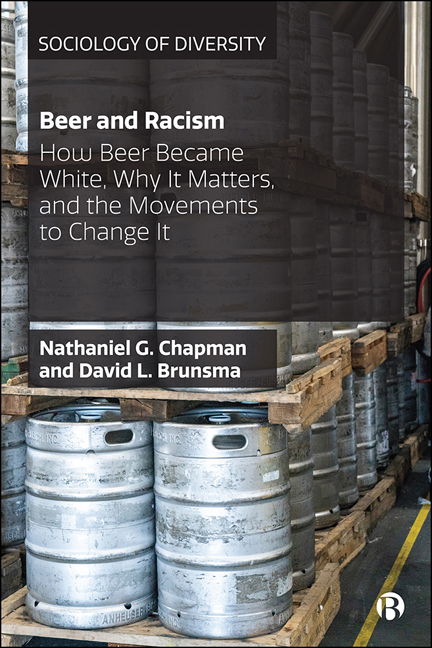Book contents
- Frontmatter
- Dedication
- Contents
- About the Authors
- Acknowledgments
- Foreword
- Series Editor Preface
- 1 Brewing Up Race
- 2 Racism, Brewing, and Drinking in US History
- 3 The Making of the (White) Craft Beer Industry
- 4 The Paths to Becoming a Craft Brewer and Craft Beer Consumer
- 5 Exposure, Marketing, and Access: Malt Liquor and the Racialization of Taste
- 6 Gentrification and the Making of Craft Beer White Spaces
- 7 #WeAreCraftBeer: Contemporary Movements to Change the Whiteness of Craft Beer
- Appendix A Respondents to the Semi-Structured Interviews
- Appendix B Interview Protocol
- References
- Index
1 - Brewing Up Race
Published online by Cambridge University Press: 25 February 2021
- Frontmatter
- Dedication
- Contents
- About the Authors
- Acknowledgments
- Foreword
- Series Editor Preface
- 1 Brewing Up Race
- 2 Racism, Brewing, and Drinking in US History
- 3 The Making of the (White) Craft Beer Industry
- 4 The Paths to Becoming a Craft Brewer and Craft Beer Consumer
- 5 Exposure, Marketing, and Access: Malt Liquor and the Racialization of Taste
- 6 Gentrification and the Making of Craft Beer White Spaces
- 7 #WeAreCraftBeer: Contemporary Movements to Change the Whiteness of Craft Beer
- Appendix A Respondents to the Semi-Structured Interviews
- Appendix B Interview Protocol
- References
- Index
Summary
The whiteness of craft beer in the US
Take a look around: at your local grocery store; the posts on your friends’ social media; one of your favorite restaurants; the advertisements posted around you; fueling up at the gas station; watching an international soccer tournament; or a friendly drive down a main street of your town or city. Beer, more particularly, craft beer, is everywhere. There are more breweries in operation now than at any other time in the history of the US— with the vast majority of these operating as local microbreweries (60.7 per cent) and brewpubs (34.8 per cent) (Brewers Association, 2019a). The beer produced by the almost 8,000 total US breweries is distributing to a broader spectrum of outlets than ever before (NBWA, 2019a). Ultimately, the consumption of beer and craft beer is at an all-time high, capturing some 49 per cent of alcohol consumption, with the proportion of craft beer consumption growing the fastest within total beer consumption (BI, 2019). Craft beer has centrally established itself within the US brewing landscape within a fairly short period of time and is becoming an interwoven aspect of social, cultural, economic, and political life— much like beer, brewing, and drinking was at earlier points in US history.
The contemporary landscape of brewing is one of: beer tastings at your local grocery store; beer festivals throughout the year; an increase of homebrewers, homebrewing clubs, and homebrewing competitions; beer trading; online craft beer social media; breweriana collectors and the rise of beer history tours and museum collections; the building of new breweries, brewpubs, and gastropubs in the development of neighborhoods; collaborations between musicians and brewers; online beer, brewing, and beer culture discussion groups; local and regional beer tours; an increase in the gastronomy and culinary import of craft beer and food pairings; family-friendly beer spaces; and an increasing presence in colleges and universities through fermentation science programs. Craft beer seemingly provides so much more than just variety in the experience of consuming this historic beverage— it is now becoming woven into the fabric of the lives of Americans— yet, this has always been the case. Indeed, as the pioneers of craft beer have helped craft beer carve out its space within the US brewing industry, its reach into the everyday lives of Americans is becoming something of sociological interest.
- Type
- Chapter
- Information
- Beer and RacismHow Beer Became White, Why It Matters, and the Movements to Change It, pp. 1 - 26Publisher: Bristol University PressPrint publication year: 2020



